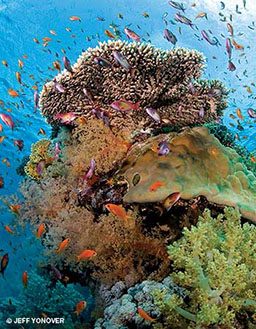Nine villages line a bay on Waigeo Island in Raja Ampat, Indonesia. During a visit by representatives of Seacology, a California-based nonprofit working to protect threatened island ecosystems around the world, one village chief requested paved walking paths.
“We thought, what an odd thing to request,” said Seacology executive director Duane Silverstein. “But our philosophy is that we’ll do what the village wants as long as it isn’t a bad thing.” Then he learned that village paths become water-filled ruts in the rainy season, which meant paved walkways would help prevent malaria. The chief later told the organization that the Indonesian government occasionally provided the village with projects that the government thought the people wanted. “Seacology was the first to provide us with what we asked for,” the chief said.
That sums up the philosophy of the organization, which was founded in 1991 and now has more than 244 projects in 51 countries on 149 islands to its credit. Seacology provides something tangible, such as those paved walkways, in exchange for residents promising to protect a specified area. Each of the nine villages on Waigeo received a project from Seacology and in return agreed to ban fishing in a 123,553-acre marine protected area for 10 years.
On Havelock Island in the Andamans near India, villagers requested an environmental education center in exchange for creating a 2,175-acre no-take marine reserve off a beach that Time magazine once called the most beautiful in Asia. Leatherbacks had nested on the beach historically but no longer appeared. The first year the reserve was established, Silverstein reported, leatherbacks returned to nest there and have been back every year since.

Seacology identifies projects through a network of field representatives on islands around the world, through staff and board-member travel and connections, and through the grapevine — a.k.a. the “coconut wireless.”
“If a village has a worthy project, we judge it on its merits,” Silverstein said. “Our view is that essentially all of the world’s coral reefs are threatened to some degree or another, so we don’t think it’s necessary to spend hundreds of thousands of dollars to say this reef is more threatened than that one. We very much respect the knowledge of local people. If a village chief says his grandfather used to go out and come back in an hour-and-a-half with three buckets of large fish and now he spends six hours and gets one bucket of small fish, that’s proof enough for us.”
The only strict requirement is that a project occurs on an island. “The vast majority of all plant and animal extinctions have taken place on islands, and almost no one knows that,” he explained. “Hawaii has two-tenths of 1 percent of the U.S. land mass but is home to 72 percent of all plant and animal extinctions. On some islands, 30 percent of the species are found nowhere else.”
In places without indigenous people, the organization looks at modest-sized interventions that can make a long-term difference in lieu of tangible projects. “For example,” Silverstein said, “Jamaica’s Oracabessa Bay is a no-take marine reserve, but rangers were in an office a mile inland. When poachers came, they were gone by the time rangers knew they were there. We donated money to repurpose shipping containers into an office right on the coast. Since 2011, coral coverage there has gone up 53 percent and fish mass 554 percent.”
Seacology takes donors and potential donors to visit projects several times a year. “We pay for equipment and supplies, but much of the work is provided by volunteers,” Silverstein said. “That saves money, but more important, when people build a project it becomes theirs. We have a great track record of villagers maintaining projects.”
Catherine Gerber of Austin, Texas, who is in medical sales, was searching for a life-changing trip when she came across Seacology in 2008. She went to Madagascar and Fiji that year and has since been on several other trips.
“The communities put on huge celebrations — absolutely majestic displays of gratitude — for what Seacology does,” Gerber said. “You get in touch with the community and see the importance of the project. I wouldn’t just contribute money to something I knew nothing about. Here, you see it, taste it, feel it. There’s no more rewarding way to contribute, and just writing a check can’t compare with seeing the concrete result.”
© Alert Diver — Q1 Winter 2014